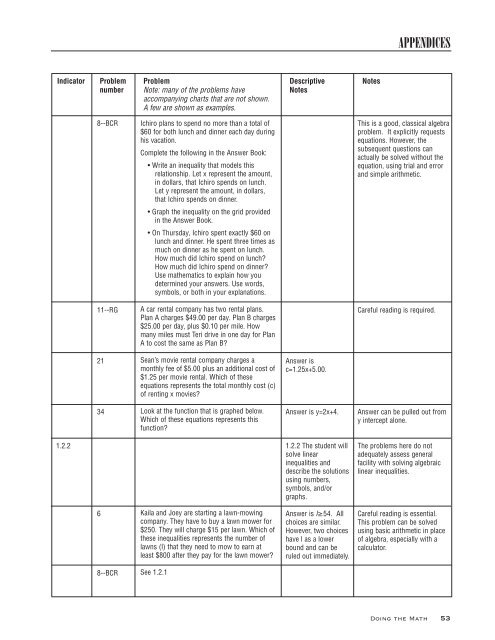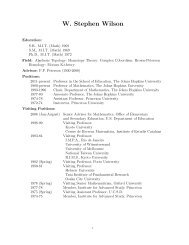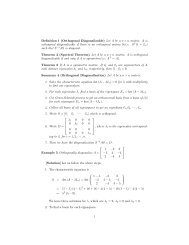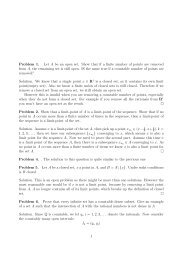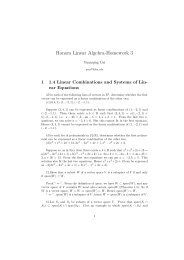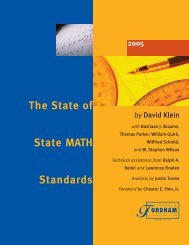Doing the Math - JHU Mathematics - Johns Hopkins University
Doing the Math - JHU Mathematics - Johns Hopkins University
Doing the Math - JHU Mathematics - Johns Hopkins University
Create successful ePaper yourself
Turn your PDF publications into a flip-book with our unique Google optimized e-Paper software.
Indicator Problem Problem Descriptive Notes<br />
number Note: many of <strong>the</strong> problems have Notes<br />
accompanying charts that are not shown.<br />
A few are shown as examples.<br />
1.2.2<br />
8--BCR<br />
11--RG<br />
21<br />
34<br />
6<br />
8--BCR<br />
Ichiro plans to spend no more than a total of<br />
$60 for both lunch and dinner each day during<br />
his vacation.<br />
Complete <strong>the</strong> following in <strong>the</strong> Answer Book:<br />
• Write an inequality that models this<br />
relationship. Let x represent <strong>the</strong> amount,<br />
in dollars, that Ichiro spends on lunch.<br />
Let y represent <strong>the</strong> amount, in dollars,<br />
that Ichiro spends on dinner.<br />
• Graph <strong>the</strong> inequality on <strong>the</strong> grid provided<br />
in <strong>the</strong> Answer Book.<br />
• On Thursday, Ichiro spent exactly $60 on<br />
lunch and dinner. He spent three times as<br />
much on dinner as he spent on lunch.<br />
How much did Ichiro spend on lunch?<br />
How much did Ichiro spend on dinner?<br />
Use ma<strong>the</strong>matics to explain how you<br />
determined your answers. Use words,<br />
symbols, or both in your explanations.<br />
A car rental company has two rental plans.<br />
Plan A charges $49.00 per day. Plan B charges<br />
$25.00 per day, plus $0.10 per mile. How<br />
many miles must Teri drive in one day for Plan<br />
A to cost <strong>the</strong> same as Plan B?<br />
Sean’s movie rental company charges a<br />
monthly fee of $5.00 plus an additional cost of<br />
$1.25 per movie rental. Which of <strong>the</strong>se<br />
equations represents <strong>the</strong> total monthly cost (c)<br />
of renting x movies?<br />
Look at <strong>the</strong> function that is graphed below.<br />
Which of <strong>the</strong>se equations represents this<br />
function?<br />
Kaila and Joey are starting a lawn-mowing<br />
company. They have to buy a lawn mower for<br />
$250. They will charge $15 per lawn. Which of<br />
<strong>the</strong>se inequalities represents <strong>the</strong> number of<br />
lawns (l) that <strong>the</strong>y need to mow to earn at<br />
least $800 after <strong>the</strong>y pay for <strong>the</strong> lawn mower?<br />
See 1.2.1<br />
Answer is<br />
c=1.25x+5.00.<br />
Answer is y=2x+4.<br />
1.2.2 The student will<br />
solve linear<br />
inequalities and<br />
describe <strong>the</strong> solutions<br />
using numbers,<br />
symbols, and/or<br />
graphs.<br />
Answer is l≥54. All<br />
choices are similar.<br />
However, two choices<br />
have l as a lower<br />
bound and can be<br />
ruled out immediately.<br />
APPENDICES<br />
This is a good, classical algebra<br />
problem. It explicitly requests<br />
equations. However, <strong>the</strong><br />
subsequent questions can<br />
actually be solved without <strong>the</strong><br />
equation, using trial and error<br />
and simple arithmetic.<br />
Careful reading is required.<br />
Answer can be pulled out from<br />
y intercept alone.<br />
The problems here do not<br />
adequately assess general<br />
facility with solving algebraic<br />
linear inequalities.<br />
Careful reading is essential.<br />
This problem can be solved<br />
using basic arithmetic in place<br />
of algebra, especially with a<br />
calculator.<br />
<strong>Doing</strong> <strong>the</strong> <strong>Math</strong> 53


